- Home
- The Hacks
-
- Leadership
- Organizational & Planning
- Community Relations
- Upstream Advocacy
- Legal Structure & Obligations
- Fiscal Structure
- Fundraising
- Ordering, Vending, & Inventory
- Filing & Documentation
- Boards & Governance
- Policies, Procedures, & Programs
- Workforce Development
- Data & Reporting
- Resources
Hacks for SSP Fundraising
“I have found that among its other benefits, giving liberates the soul of the giver.”
Fundraising for Harm Reduction
Best Practices for Fundraising in Harm Reduction
Funding:
Government Contracts and Grants
Funding:
Foundation Grants
Funding:
Individual Donors
Funding:
Goods and Services
Funding:
Corporate Gifts
Researching Funding Opportunities
Tips for Writing Grants, Requests and Requests for Proposals
Tips for Creating Budgets for Grants and Requests
More Resources
Let Us Know About A Resource
During our development Harm Reduction Hacks have collected together a large number of resources from around the web you can find these in our resource folder in Google Docs. We are also always looking for more so help us by suggesting any resources we may have missed.
External Resources
Copyright
Disclaimer
We do not claim that this is an exhaustive set of strategies, shortcuts, or tips for running an SSP. What we do suggest is that Harm Reduction Hacks offers down-to-earth, practical information for being a better leader, starting and running an SSP, and providing syringe access services. We feel we can say this with confidence because the Hacks are based on interviews with, and the experiences of, literally generations of people who have been doing harm reduction work.
Please note that nothing in this guide should be construed as legal advice. Please consult an attorney local to your area to ensure your program is in compliance with all local, state and federal regulations that apply to your situation.
Harm Reduction Hacks site design and implimentation by Nigel Brunsdon
This site is protected by reCAPTCHA and the Google
Privacy Policy and Terms of Service apply.


